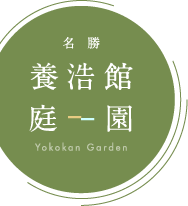A water garden in the city of water.- a villa belonging to the feudal lord of the Fukui Domain, Matsudaira.
Due to the synergy among the outstanding aquatic setting’s formation, the garden and building, Yokokan Garden exudes a complete sense of unity. Yokokan Garden is situated along the area where the outer moat of Fukui Castle, which used to be enclosed by 5 concentric moats, had once existed. It is an elegant and subtly graceful garden of water that had fully utilized the abundance of clean water in the castle town.
Yokokan Garden is a stroll garden featuring a pond, trees and a sukiya-style building/house.

Yasushi Tagawa.1942.Japanese architecture Yokokan.Tokyo:Syokokusya
It became the residence of the third feudal lord, Tadamasa Matsudaira(1623‐1645). Since, at first, water was drawn from the Shibahara channel and channeled directly into the villa, it came to be called “Osensui Yashiki.” The villa was first mentioned in a historical account of the birth of the son of Mitsumichi Matsudaira, the fourth feudal lord.

Yasushi Tagawa.1942.Japanese architecture Yokokan.Tokyo:Syokokusya
It was used by the feudal family for tea ceremonies, banquets and other forms of relaxation.

Harumichi Kitawo.1936.Sukiya Jutaku-shu (Collection of Sukiya-style Homes).Tokyo:Soubunsya
Even after the building was burned down by an air attack in 1945, the garden remained intact. In 1982, Y was recognized as a national scenic spot for retaining its original layout. Using blueprints dating from 1823, landscaping and reconstruction of the building began. After approximately 8 years, the garden was opened to the public in 1993.

Harumichi Kitawo.1936.Sukiya Jutaku-shu (Collection of Sukiya-style Homes).Tokyo:Soubunsya

A portion of the Fukui Funkan no Zu (a map drawn by a Fukui Domain feudal retainer found in the Matsudaira Collection stored at Fukui Prefectural Library) is attached to a topographical map of Fukui at that time (scale of 1/5000).



